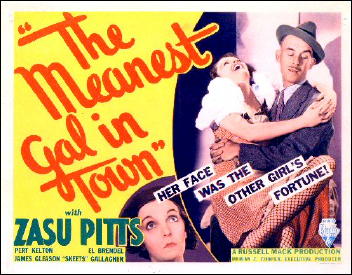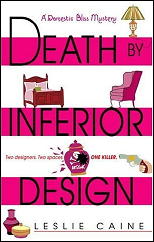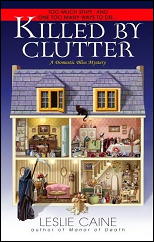July 2011
Monthly Archive
Wed 20 Jul 2011
REVIEWED BY WALTER ALBERT:
THE MEANEST GAL IN TOWN. RKO, 1934. ZaSu Pitts. Pert Kelton, El Brendel, James Gleason, “Skeets” Gallagher. Director: Russell Mack. Shown at Cinevent 40, Columbus OH, May 2008.
ZaSu Pitts hadn’t yet reduced her acting to the fluttering “dear me” mannerisms that most people associate with her, and she does a decent job of playing a small-town shop owner who’s getting tired of waiting for long-time beau Chris (El Brendel), the local barber who won’t ask Tillie to marry him until he’s successful enough to afford a second chair.
Tired of waiting, Tillie buys the chair for him, but her plan is railroaded by the arrival of out-of-work actress Lulu White (Pert Kelton), who promotes herself into a job as manicurist at Chris’s shop. Other complications follow, just enough of them to stretch the film to a thin 62 minutes, with an improbable ending that keeps Pitts off-screen for much of the last section of the film.
Comedian El Brendel was less irritating than in other films in which I’ve seen him, but the paring of Pitts and Brendel was not a match made in cinematic heaven. Jim Goodrich, who attended this showing with me, was not happy that ZaSu Pitts was wasted in an unpleasant role.
Mon 18 Jul 2011
Posted by Steve under
Authors[8] Comments
A PREVIOUSLY UNRECOGNIZED CRIME NOVEL BY ED LACY
by Bill Pronzini.
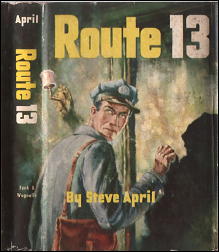
Here’s something of a surprise, at least to me: the only novel by Len Zinberg (Ed Lacy) to be published under his other pseudonym turns out to be crime fiction. As per the attached from the dj. Very scarce book; the copy I just bought is the first I’ve seen in 40 years of collecting.
STEVE APRIL – Route 13. Funk & Wagnalls, hardcover, 1954. Setting: NYC
STORY DESCRIPTION [Taken from both inside jacket flaps.]
There was a lot that Manson Cornwall wanted to do, but becoming a mailman wasn’t on his list. In spite of his uncle’s love for the postal service, he was sure it would be the dullest job in the world. What he meant to do first was graduate from high school, and then somehow he would become a doctor. But Uncle Harry was murdered, and Manny thought he had to make some money quickly to help his aunt and at the same time look for his uncle’s killer. Thelma, who lived with her family in the apartment upstairs, understood and sympathized with him, but even she lost patience when he tried to settle for quick and easy money in professional boxing.
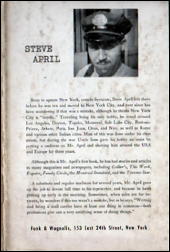
After his brief, bitter experience in the ring, Manny began job hunting, but his high school diploma wasn’t enough. Then the post office appointment for which he had applied to please his uncle came through, and Manny went to work as a mailman, determined to resign at the first possible opportunity. He was not surprised at the hard work, but what did surprise him was the pleasure he found in working with others, in the security of a steady job with a good salary, and in the fact that people depended on the mail and on him.
Letter-carrying, night school, and crime detection didn’t mix very well, but Manny combined them for a while, and by the time the sleuthing was finished he had grown up enough to distinguish between dreams of what he would be and the real world in which he had to do. He had learned that for him the post office could provide a rewarding career; in his job he was important, not just as himself, but as part of an organization doing important work and doing it well.
STEVE APRIL [A Biography of the Author, taken from the back cover.]
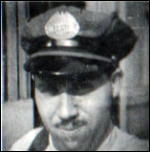
Born in upstate in New York, outside Syracuse, Steve April left there before he was ten and moved to New York City, and ever since has been wondering if that was a mistake, although he thinks New York City is “terrific.” Traveling being his only hobby, he nosed around Los Angeles, Dayton, Topeka, Montreal, Salt Lake City, Port-au-Prince, Athens, Paris, San Juan, Oran, and Nice, as well as Rome and various other Italian cities. Most of this was done under his own steam, but during the war Uncle Sam gave his hobby an assist by putting a uniform on Mr. April and shoving him around the USA and Europe for three years.
Although this is Mr. April’s first book, he has had stories and articles in many magazines and newspapers, including Collier’s, This Week, Esquire, Family Circle, the Montreal Standard, and the Toronto Star.
A substitute and regular mailman for several years, Mr. April gave up the job to devote full time to his typewriter, and because he hates getting up early in the morning. Sometimes, when sales are far between, he wonders if this wasn’t a mistake, but as he says, “Writing and being a mail carrier have at least one thing in common — both professions give one a very satisfying sense of doing things.”
Mon 18 Jul 2011
Posted by Steve under
Reviews[3] Comments
DAVID BURNHAM – Last Act in Bermuda. Charles Scribner’s Son, hardcover, 1940.
Even though there is a hint in the last paragraph that Inspector Steve Hamilton of the Bermuda Police Department may have had another case to solve, it didn’t happen. This is it, the only case he ever had — the only one recorded for posterity, that is — but nonetheless, it’s a good one. Better than good, as a matter of fact.

A thought occurred to me while reading this book, though, and I’m not exactly sure why it’s never occurred to me so strongly before, since I’ve known it all along, but this is what it was. That the settings of the mysteries that are part of the period that’s commonly known as the Golden Age of Detection – and 1940 is almost exactly in the center of the time frame, or just afterwards – that the setting and people involved were almost always of the upper crust, the jet set (before there were jets) the rich or the artsy or both.
The private eyes hung out in the gutters of society. The socialites had their world, and a certain segment of the reading population liked their detective fiction to take place in that world, not that they were part of that world, but that they enjoyed the opportunity to take a peek into that world and (perhaps) to see segments of that society broken down, just a little.
As you must have gathered by now, that’s the kind of mystery this one is. And since the youngish Inspector Hamilton’s kid sister Joan is romantically involved with the owner of the estate on the island just off Bermuda, he’s also there johnny-on-the-spot before the crime of murder is committed.
What this book is also about — and once again this is something that’s also very common in books taking place in the Golden Age of Detection — is a murder that takes place in a somehow isolated locale, in this case an island, and therefore resulting in only a limited number of suspects to be suspicious about. (Well, almost.)
The list includes the following: an young actor and a young actress; a man-about-town and his wife; a famous director’s wife; and a famous artist, female. Not to mention the host and one mystery guest, whom everyone seems to know and seems to have seen on the island before the surprise is ever announced.
Besides being involved with the host, Tony Bound –not to Inspector Hamilton’s pleasure — his sister Joan is also his “Watson,†as she amusingly discovers that a murder investigation is something very much to her liking: eavesdropping in on the questioning of the suspects, making timetables, and all of the other accouterments and other apparatus of solving a crime.
Either you like timetables in your detective fiction, or you don’t, but I do, even though I also like a private eye novel taking place in the lower echelons of society as much as anyone else. The detective work in this book I thought was excellent.
Worthy of a Queen? Yes, even so, and even with the cliched situations and settings that make themselves so noticeable that you cannot help but stumble over them, all I can say it that is it a shame that Joan never had the chance to help her big brother out like this again.
PostScript: This was the only work of crime fiction that David Burnham (1907-1974) produced, but Bill Pronzini, who provided the scan of the dust jacket above, suggests that perhaps he was also the author of Winter in the Sun (Scribner’s, 1937), a book about ranch life in the Arizona desert. The name’s the same, and the publisher’s the same, so the chances are better than good that it’s a match.
— February 2006
[UPDATE] 07-19-11. The following was sent to me by Victor Berch. I’ve decided to include it here with the review itself, rather than in the comments section:
Comment on Last Act in Bermuda, 1940.
Steve:
Bill Pronzini is certainly correct in his assumption that David Burnham, the author of Last Act in Bermuda (1940) was the author of the book Winter in the Sun (1937).
David Burnham was born March 2, 1907 in Chicago, IL, the son of an English immigrant, Claude G(eorge), a railroad traffic manager, and Mary (Gillis) Burnham, a native of Minnesota.
David was a graduate of Princeton University, where he was involved with its choral group: the Triangle Club. He and other members of the group wrote the words to a vocal score titled “Napoleon Passes.”
According to Al Hubin’s Crime Fiction Bibliography, he died in 1974. For some reason or another, I could not locate his name in the SSDI. Perhaps he had opted out of the program, which was perfectly legal way back then.
He is not to be confused with the David Burnham who was an investigative reporter for the New York Times.
Here is a list of his book publications:
1) This Our Exile. (New York: C. Scribners, 1931. London: P. Davies, 1931)
2) Wedding Song. (New York: Viking Press, 1934. London: Peter Davies, 1934)
3) Winter in the Sun. (New York: C. Scribners, 1937)
4) Last Act in Bermuda. (New York: C. Scribners, 1940)
He also has one entry in the Fictionmags Index for a short story titled “Turn the Page,†which appeared in the Saturday Evening Post Sept. 17, 1938
Victor
Sun 17 Jul 2011
REVIEWED BY MICHAEL SHONK:

CHARLIE GRACE. ABC-TV. September 14, 1995 through October 19, 1995. Created and Executive Produced by Robert Singer. CAST: Mark Harmon (Charlie Grace), Cindy Katz (Leslie Loeb), Leelee Sobieski (Jenny Grace), Robert Costanzo (Artie Crawford). Not available on DVD or for downloading. Six episodes are available on YouTube with badly out of synch copies. Total of nine episodes were reportedly made.
There is a famous drinking game featuring the TV series Bob Newhart: Every time someone says “Bob”, you take a drink. Charlie Grace is perfect for a similar game. Every time you see or hear a PI cliche or TV PI gimmick, take a drink. You won’t remember a thing after the first commercial.
Always likable Mark Harmon played Charlie Grace, a hard luck nice guy ex-cop turned PI. As a cop he turned in a group of corrupt fellow officers. Many on the force did not approve of his action. This has left Charlie less than popular with many of the LAPD.

He has an ex-wife, Holly, and a twelve year-old daughter, Jenny. He feels guilty about his failed marriage and loves his kid. How Charlie ends up raising his daughter is the single surprising twist of the series. Those curious can check out the SPOILER PARAGRAPH below this review.
Charlie has an ex-girlfriend, Cindy who is a rich powerful lawyer who keeps Charlie employed and out of jail.
He has a car like Rockford’s for his car chases. He gets shot at and beat up on a regular basis. He breaks into places illegally. He has contacts, such as a computer hacker and finder of missing people, to do the visually boring legwork.
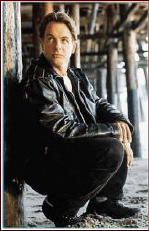
Crawford, an ex-cop due to Charlie’s whistle blowing, is now a sleazy PI. Each week, usually straining logic and believability, Crawford helps Charlie with the case.
Charlie’s office is in a pool hall.
Beautiful women fall for Charlie quickly and weekly.
Charlie is always broke, but has a beautiful two-story house in Los Angeles. The house is atop a hill, so he has to run up the stairs because there is an unseen dog that always chases him for no apparent reason.
Charlie does a voice over narration that breaks the fourth wall.
The series was never sure what it wanted to be, a 70s PI mystery or a family drama. Action scenes and cynical, sarcastic PI dialog did not mix well with the Hollywood pathos of a single Dad raising a young daughter. Charlie having to find a sitter for Jenny before he can search for the killer was not what Raymond Chandler meant when he compared a PI to a lone knight walking the mean streets.
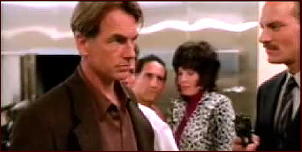
The series time period opposite Friends and Murder, She Wrote, was an additional reason this series lasted only six weeks on the air. Every TV reference book or website has errors regarding this series. IMDb claims the final three episodes were shown in May, but no other reference agrees. Crawford was not Charlie’s partner. And the big mistake involves the spoiler below this review.
In the end, Charlie Grace was just one more short-lived TV detective series relatively few people even saw, let alone remember.
*** SPOILER ALERT ***
Charlie’s ex-wife, Holly (Harley Jane Kozak) was introduced with Jenny in the pilot. The Ex had remarried a rich man who neglected Jenny. The first episode after the pilot featured Step-Dad murdered and Mom arrested.
The twist at the end revealed Mom did kill her second husband. The rest of the series dealt with the melodramatic trauma Jenny goes through with her Mom in prison for murder, and insecure parent Charlie trying to help her while solving crimes.
Sat 16 Jul 2011
A 1001 MIDNIGHTS Review
by Marcia Muller
MARTHA ALBRAND – Manhattan North. Coward McCann & Geoghegan, hardcover, 1971. Avon, paperback, 1973.
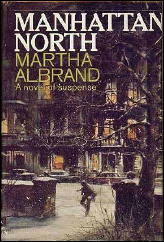
The cover of the paperback edition of this novel hails its author as “the mistress of romantic intrigue.” This is a blatant case of mislabeling, probably in an effort to take advantage of the great popularity of Gothic suspense novels in the early Seventies; and fans of that genre who bought this novel on the basis of the cover line must have been sorely disappointed.
Albrand’s work is suspenseful, but in a realistic, contemporary fashion. She deals with political and other problems of current concern (and in Manhattan North she is a good bit ahead of the times, writing of subjects that are frankly controversial), and her settings and characters are reflective of the world as we know it. True, she generally incorporates a love interest in her stories, but this does not always end on a happily-ever-after note.
Manhattan North begins with the fatal stabbing of Supreme Court Justice Clark Jamison Butworth, who has been found in a snowbank in Central Park. The killing of Butworth, a close adviser to the president, prompts the formation of a committee to “investigate the effect of violence on the judiciary and terror as a measure of influencing judicial decisions.”
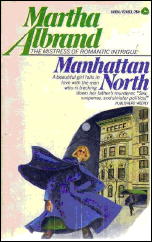
Tad Wood, a young liberal lawyer, is asked to organize it, and facts soon emerge that begin to disturb him: The police investigation into Butworth’s death is being soft-pedaled, apparently on orders from the administration; there are irregularities about the death, such as the fact that Butworth was disguised in a wig and goatee at the time he was murdered.
Tad digs deeper, makes the acquaintance of Butworth’s daughter, and is on the scene to help her when she is attacked by a burglar. Or was it a simple case of burglary?
As Tad investigates, his personal life also plagues him. His godfather’s daughter, Lindy, has been sent abroad quite suddenly, and he receives an urgent plea from her for help. A psychic he has consulted about the Butworth case turns up dead, an apparent suicide.
This is an engrossing novel that takes a hard look at some of the stickiest issues confronting contemporary society. Albrand’s early work also concerned itself with current issues, such as her two novels of the wartime Dutch Underground, No Surrender (1942) and Without Orders (1943). A later novel, A Call from Austria (1963), takes up the theme of escaped Nazi war criminals, and Zurich AZ/900 (1974) is a novel of international medical intrigue.
———
Reprinted with permission from 1001 Midnights, edited by Bill Pronzini & Marcia Muller and published by The Battered Silicon Dispatch Box, 2007. Copyright © 1986, 2007 by the Pronzini-Muller Family Trust.
Sat 16 Jul 2011
Posted by Steve under
Reviews1 Comment
IT IS PURELY MY OPINION
Reviews by L. J. Roberts
KERRY GREENWOOD – Dead Man’s Chest. Poisoned Pen Press, hardcover/trade paperback, November 2010.
Genre: Historical Mystery/Private Eye. Leading character: Phryne Fisher (18th in series). Setting: Australia/Golden Age (1920s).
First Sentence: Dot opened her eyes.
The Honorable Phryne Fisher, private investigator, takes her family on vacation to a house she’s been lent in Queenscliff, Australia. The owner had promised Phryne, her maid Dot, adopted daughters Ruth and Jane, and dog Molly, would be well looked after by Mr. and Mrs. Johnson.
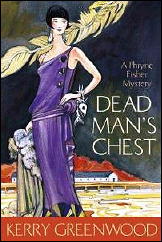
However, when they arrive, the Johnson’s and their possessions are gone, the larder is completely empty and the back door wide open. The family settles in to make do while Phryne tries to find out what’s happened to the Johnsons, and the girls are concerned about the phantom snipper who is cutting off girls’ braids.
From the very first page, you glean an insight into several of the principal characters. From the first few pages, you can’t help but love Phryne. My opinion has not changed; I really to want to be Phryne Fisher when I grow up.
Phryne was not born to money, so she knows hard times, but through twists of fate, is now titled, wealthy and very independent. She is kind, protective of those less fortunate, impatient with fools, has no tolerance for bigots, intelligent, observant, shoots, flies a plane, can defend herself and has a non-emotional attitude toward sex.
Greenwood skillfully provides insight into those surrounding Phryne with simple descriptions of their bedrooms, including the fact that Jane reads Dorothy L Sayers. It is fun to look at the 1920s through Fisher’s eyes. We see the impact of the War, learn about the surrealists — which did lead to a conversation that was a bit esoteric for me — see an early film being made, and are treated to a view of life in Australia in this time.
Greenwood creates such a strong sense of place with descriptions, she paints a visual scene. Her wonderful descriptions of food left me hungry; I’m delighted there is a recipe at the end of the book.
The plot was a bit unusual for Phryne. As the characters are on vacation, in a sense so were we. The mystery is certainly there and although there are deaths, as Phryne says, “I got through the week without a murder.” Well, sort of; at least none at her hand, and when Phryne solves a crime, it makes perfect sense had one been paying attention.
Dead Man’s Chest is yet another wonderful book in an altogether delightful series. From literary quotes, to delightful characters, a touch of humor, and unusual crimes to solve; I highly recommend it.
Rating: Good Plus.
Previously reviewed on this blog:
Death Before Wicket (by L. J. Roberts)
Sat 16 Jul 2011
REVIEWED BY DAN STUMPF:
SECONDS. Paramount, 1969. Rock Hudson, Salome Jens, John Randolph, Will Geer, Jeff Corey, Richard Anderson, Frances Reid, Murray Hamilton. Based on the novel by David Ely. Cinematography: James Wong Howe. Director: John Frankenheimer.
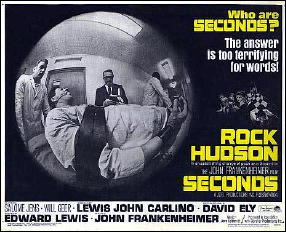
James Wong Howe, who was last mentioned here for his work on Out of the Fog, also handled the camera on Seconds, a film which has been described as “John Frankenheimer’s cinematic Xanadu,” and to be sure, director Frankenheimer and photographer Wong Howe fill this thing with all sorts of artsy movie tricks, including slow motion, fish-eye lens, odd angles and eye-blink editing, all to produce a sense of disorientation and alienation in the creepy tale of a man (John Randolph) who buys a chance to be young and sexy again (Rock Hudson) only to find himself drowning in the shallowness of his new life.
The antic artistry of the thing works, even if it gets pretentious after a while, as a growing sense of claustrophobic paranoia suffuses the film, but all the cinematic slight-of-hand seems less effective than the sinister acting by seasoned pros like Will Geer, whose expression can pass from fatherly to frightening without changing a wrinkle; Jeff Corey, who makes Evil seem distracted and self-absorbed; Wesley Addy as an overly-unctuous manservant; and even the once-blacklisted Nedrick Young as a party guest whose annoyance gets chillingly ominous.
If Seconds succeeds at all — and I think it does — it’s less because of the camera and more due to the folks in front of it.
Fri 15 Jul 2011
LESLIE CAINE – Manor of Death. Dell, paperback original; 1st printing, February 2006.
I do my best to keep up to date with all of the mysteries that come out every month, or at least those that come out in paperback. Honest, I do. I buy almost all of them, but I have to confess, at 30 or so a month, that averages out to a book a day, and in my reclining years it takes me two or three days to read a detective novel, and those are on the good days. You do the math.
And there are all of the older books in this house to be read. This book by Leslie Caine came out in February, and it’s being reviewed in February. Can I keep this up? We will have to see. I’ll give it my best shot, but I will also promise you this: No promises.
There are two previous books in Caine’s “Domestic Bliss†series, namely:
Death by Inferior Design. Dell, pbo, October 2004.
False Premises. Dell, pbo, June 2005.
Take a look at the short amount of time between these three books. And do you know what else? All of the books are nearly 400 pages long. The lady writes faster than I can read, and I’m not kidding.
Here’s a quick recap of the series, using Amazon.com as a guide. In Inferior Design, in trying to determine which of three couples are her real parents, two sets of which end up being killed – can that be right? – home decorator/designer (and primary series character) Erin Gilbert ends up nearly being murdered herself.
In Premises, Erin finds that the antiques that she has used to decorate a wealthy client’s home have all been replaced by fakes.
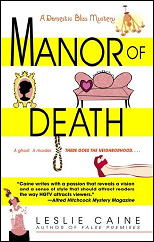
Her “nemesis†in these three books, if you care to call him that, segueing into Manor of Death now as well, is her primary competitor in Crestwood CO, Steve Sullivan. (If you don’t get the play on names, let me be blatant about it.) Sullivan is, of course, also a strong quasi-romantic interest in the stories as well.
The major events in Manor occur in the house next door to the one where Erin is currently renting living space for her and her cat. It seems as though the ghost of a young girl who fell, committed suicide, or was murdered forty years ago has now come back and is haunting the present inhabitants. Erin’s involvement is ensured by the fact that she has been hired to remodel the house, including the girl’s former room and the upstairs tower from which she met her death.
Erin, who tells the story in first person singular, is appropriately smart and sassy, but the pacing is oddly off. The opening premise runs on to great length, with only the ghostly happenings (supposedly) and a seance to keep one’s interest alive.
Or, and this is entirely possible, my interest, at least. With home decorating such a powerfully significant part of Erin’s life, you might question whether or not I am among the intended readership for this book, and that would probably be a fair inquiry to make, if you were to make it.
On page 106, there is at last a death to investigate. By this time in the series Erin has become a good friend with the primary investigating officer (female and in no way competition for Sullivan), and as good friends do, the police politely make themselves (relatively) scarce. This allows Gilbert and Sullivan to combine forces and dig up the necessary clues from the past – high school yearbooks and the like – on their own.
By page 273 the story has finally started to move into higher gear. I went along for the ride, but to tell you the truth, by that time all of the squabbling neighbors and their ofttimes trifling concerns had largely taken their toll on me.
The mystery is not bad. The problem is that it’s too small for the book. I’ll take that back. That was my problem, possibly gender based, and it may not necessarily be yours.
— February 2006
[UPDATE] 07-15-11. First of all, there have been several more books in the series. Most series these days end after three. With seven in total, I believe this one may easily be called successful:
4. Killed by Clutter (2007)
5. Fatal Feng Shui (2007)
6. Poisoned by Gilt (2008)
7. Holly and Homicide (2009)
There has been a gap between 2009 and now, however, and with nothing in the pipeline, as far as I’ve been able to discover, this “Domestic Bliss” series may have succumbed to declining sales and/or the general overall malaise in the mass market paperback mystery business.
Under her own name, Leslie O’Kane, the author has also written seven books about Molly Masters (1996-2002), a greeting card designer (or cartoonist — I am not clear about this) and three books about Allie Babcock (1998-2002), a dog therapist.
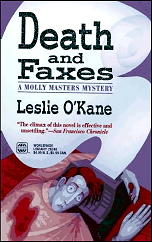
I can’t tell you for sure whether or not I bought all of O’Kane’s books, either as herself or as Leslie Caine, but I may have quite a high percentage of them, although the ones about the greeting card designer are kind of iffy. And now that I think about it, the ones about the dog therapist are even iffier.
As I said in my review, these modern day cozies are not meant for male readers. And now, some five years after I wrote the review above, the bulk of mass market paperback mysteries are this kind of book (up to ninety percent?). By this kind of book, I mean those involving hobbies (quilting), small unique kinds of businesses or occupations (herb shops), animal trainers (cat sitters) and the like.
It’s been quite easy to go into Borders these past few months and come out empty-handed. My problem of buying too many mysteries has been solved for me.
At which point my wife would be laughing at me, if she were ever to read that last statement. There are still many mysteries published in hardcover and trade paperback quite worthy of attention, even if they aren’t sold in Borders, and online they can usually be obtained at huge discounts, especially if you’re willing to wait a while.
And there are older mysteries which I do not yet own, and many of them can also be obtained inexpensively online. And so I do.
Wed 13 Jul 2011
Posted by Steve under
Reviews[5] Comments
REVIEWED BY BARRY GARDNER:
JONATHAN ROSS – Murder Be Hanged. George Rogers #18. St. Martin’s, hardcover, 1993. Prior UK edition: Constable, hardcover, 1992.
I am a Jonathan Ross fan, and it irritates me no end that so few of his books have been reprinted in paperback in this country. He deserves a wider audience here. Obviously his hardcovers have met with some degree of success both here and Great Britain, as this is the eighteenth tale featuring Detective Superintendent George Rogers.

Ross himself is former Detective Chief Superintendent, and though the Rogers books are not as rigorously procedural as some, the qualify for the cognomen. He obviously knows whereof he writes, and even better, writes quite well of what he knows.
George is feeling his years. Of late he has been more interested in golf then women, a state of affairs so at odds with the norm that he fears the change of life is upon him. His attention is distracted from his woes by a call from a young man who wants to meet with him in private, to alert him of a crime that may happen.
Rogers meets him after dark, and learns that the teenager fears that his stepfather is planning to murder his mother. There is nothing to be done, of course, lacking evidence, but Rogers promises to keep an eye on things.
Then the mother is the subject of an attempted shooting, the step-father is missing, and Rogers and his trusty second, David Linegard, have a mystery on their hands. Appearances are deceiving, though (aren’t they always?), and the situation is deeper and darker than it first appeared. Before it’s solved there is murder done, though to and by whom may surprise you.
As always, Rogers a thorny, horny, and engaging lead, and the book is peopled with sharply drawn characters. Ross’s tales are not as deep and philosophical as some, perhaps, but they are far from trivial, and always interesting. The detection is realistic, solutions are never dragged in from left field, the prose is direct and forceful, and the narrative never lags.
Ross is a thoroughgoing professional. If he does not quite belong in the first rank with Hill and Harvey, he is comfortably high up in the second, and I invariably enjoy his books.
— Reprinted from Ah, Sweet Mysteries #7, May 1993.
Bibliographic Notes: There have been 21 novels in the Inspector George Rogers series, all written between 1968 and 1997. Jonathan Ross was the pen name of John Rossiter (1916- ), who published another dozen or so spy and/or adventure novels under his own name.
Tue 12 Jul 2011
Posted by Steve under
Reviews[6] Comments
THE BACKWARD REVIEWER
William F. Deeck
KEN CROSSEN – The Case of the Phantom Fingerprints. Vulcan Publications #5, digest-sized paperback original, 1945.
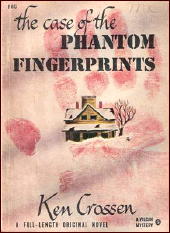
This is the second of two novels featuring the talents of Jason Jones, a very unusual detective first grade who is a fat, lazy, geranium-raising sleuth — the “poor man’s Nero Wolfe” — and the presence of, for he doesn’t seem to have any talent, Necessary Smith, private detective.
In this case, a straightforward murder is committed. Morris Block, Broadway producer and blackmailer, is stabbed to death at his home during a party. The murderer’s fingerprints are on the knife. When the police finish fingerprinting the group and discover a match, the killer vanishes from the house, despite all the doors being guarded by the police and the few unlocked windows having the snow on their sills undisturbed.
This is a fair-to-middling “impossible situation” novel. Those who have read Carter Dickson’s Nine–And Death Makes Ten will know how the murderer manages to disappear. One of the clues is a mystery novel, The Laughing Buddha Murders, another impossible-situation novel, by Richard Foster, one of Crossen’s pseudonyms, and published also by Vulcan.
— From The MYSTERY FANcier, Vol. 12, No. 3, Summer 1990.
Bibliographic Notes: The other, earlier case tackled by the detective duo of Jason Jones and Necessary Smith was The Case of the Curious Heel (Eerie Series, paperback, 1944).
If I am reading Bill correctly here, one of the clues in solving this mystery was another book by the same author but under a pen name. This can’t have happened often. (It is as if Sir Henry Merrivale referenced Gideon Fell in one of his locked room adventures.) Can anyone come up with another such instance?
« Previous Page — Next Page »
